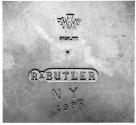Animal bowl
As a silversmith who came of age in the last quarter of the twentieth century, Robert Butler focuses on formal hollowware, an unusual choice in a generation that has generally favored jewelry as the primary form of expression. From 1972 to 1976, Butler studied with silversmith Michael Murray in London and registered his “RAB” mark at Goldsmiths’ Hall. Upon his return to the United States about 1976, Butler worked briefly at Gebelein Silversmiths in Boston and soon established his own workshop.
This elegant vessel, the sole commission of contemporary American silver ordered by the Museum, had its origins in a baby cup with an elephant-head handle fashioned by Butler. For this bowl, he used the elephant as a motif in a richly ornamented scene of African wildlife in which the creased and weathered heads serve as the support. Repousséd crocodiles emerge from a smoothly planished, “watery” base, while marsh grass, cut with a scroll saw, is reflected below. The handles are formed by delicate reeds, and intertwined gilded giraffes, made from lost-wax casts, surmount the whole.
Because of his contact with colonial silver at the Museum of Fine Arts, Boston, Butler enlarged his “RAB” mark, which he had used in London, to “RaBUTLER.” He learned that the simple initials first used by colonial American silversmiths followed the pattern that was established by London’s Goldsmiths’ Hall and brought to this country by immigrant craftsmen. However, since American silversmiths were not administered by the English guild system, they were free to alter their marks, and, by the late eighteenth century, they commonly used full surnames. Like his colonial counterparts, Butler surmised that such a mark could bring his name to a wider clientele.
The graceful profile and volume of the tureen, with its elliptical form, recall the achievements of nineteenth-century presentation silver. Yet despite the formality of the arrangement, the ornamentation is quite contemporary. The bowl showcases Butler’s remarkable silversmithing skills in raising, lost-wax casting, and chasing.
This text has been adapted from "Silver of the Americas, 1600-2000," edited by Jeannine Falino and Gerald W.R. Ward, published in 2008 by the MFA. Complete references can be found in that publication.












